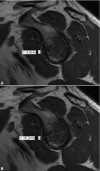Clinical Validation of the Glenoid Track Concept in Anterior Glenohumeral Instability
- PMID: 35966420
- PMCID: PMC9365485
- DOI: 10.1055/s-0041-1741022
Clinical Validation of the Glenoid Track Concept in Anterior Glenohumeral Instability
Abstract
Objective To evaluate the correlation of the glenoid track and glenoidal bone loss with the recurrence dislocation rate and the Rowe score. Methods Retrospective study that assessed the glenoid track and glenoidal bone loss through preoperative magnetic resonance imaging. Patients undergoing primary arthroscopic repair of anterior Bankart were included. Patients with glenoidal bone loss greater than 21%, rotator cuff tear, scapular waist fracture, and posterior or multidirectional instability were not included. Rowe score were the primary outcome, and the recurrence rate was the secondary outcome. Results One hundred and two patients were included. Postoperative recurrent instability was reported by 8 patients (7.8%). Four patients (50%) in the group with recurrence presented glenoidal bone loss greater than 13.5% against 24 (25.5%) in the group without recurrence ( p = 0.210), with a negative predictive value of 94.6%. Three patients (37.5%) in the recurrence group were considered off-track, against 13 (13.8%) in the group without recurrence ( p = 0.109), with a negative predictive value of 94.2%. Patients with absolute glenoid track value ≤ 1.5 mm had worse results in relation to the recurrence group, with 6 patients (75%) presenting recurrence ( p = 0.003). Conclusion Off-track injury and glenoidal bone loss greater than the subcritical are not related to the recurrence rate and Rowe score, despite the high negative predictive value. The cut of the absolute value of the glenoid track at 1.5 mm had a significant relationship with the recurrence rate.
Keywords: Bankart lesions; glenoid cavity; shoulder dislocation.
Sociedade Brasileira de Ortopedia e Traumatologia. This is an open access article published by Thieme under the terms of the Creative Commons Attribution-NonDerivative-NonCommercial License, permitting copying and reproduction so long as the original work is given appropriate credit. Contents may not be used for commecial purposes, or adapted, remixed, transformed or built upon. ( https://creativecommons.org/licenses/by-nc-nd/4.0/ ).
Conflict of interest statement
Conflito de Interesses Os autores declaram não haver conflito de interesses.
Figures




Similar articles
-
Remplissage Versus Modified Latarjet for Off-Track Hill-Sachs Lesions With Subcritical Glenoid Bone Loss.Am J Sports Med. 2018 Jul;46(8):1885-1891. doi: 10.1177/0363546518767850. Epub 2018 Apr 19. Am J Sports Med. 2018. PMID: 29672132
-
Arthroscopic Bankart repair associated with subscapularis augmentation (ASA) versus open Latarjet to treat recurrent anterior shoulder instability with moderate glenoid bone loss: clinical comparison of two series.Musculoskelet Surg. 2017 Apr;101(1):75-83. doi: 10.1007/s12306-016-0446-8. Epub 2016 Dec 21. Musculoskelet Surg. 2017. PMID: 28004306
-
Clinical Validation of the Glenoid Track Concept in Anterior Glenohumeral Instability.J Bone Joint Surg Am. 2016 Nov 16;98(22):1918-1923. doi: 10.2106/JBJS.15.01099. J Bone Joint Surg Am. 2016. PMID: 27852909
-
Arthroscopic Bankart Repair With Remplissage in Comparison to Bone Block Augmentation for Anterior Shoulder Instability With Bipolar Bone Loss: A Systematic Review.Arthroscopy. 2021 Feb;37(2):706-717. doi: 10.1016/j.arthro.2020.08.033. Epub 2020 Sep 7. Arthroscopy. 2021. PMID: 32911004
-
When to Abandon the Arthroscopic Bankart Repair: A Systematic Review.Sports Health. 2020 Sep/Oct;12(5):425-430. doi: 10.1177/1941738120940676. Epub 2020 Jul 27. Sports Health. 2020. PMID: 32716726 Free PMC article.
Cited by
-
Hill-Sachs Lesion: Diagnosis, Classification, and Treatment.Rev Bras Ortop (Sao Paulo). 2025 Jul 10;60(2):1-8. doi: 10.1055/s-0045-1809339. eCollection 2025 Apr. Rev Bras Ortop (Sao Paulo). 2025. PMID: 40656672 Free PMC article.
-
[Hill-Sachs Lesion: Diagnosis, Classification, and Treatment].Rev Bras Ortop (Sao Paulo). 2025 Jul 10;60(2):1-8. doi: 10.1055/s-0045-1809525. eCollection 2025 Apr. Rev Bras Ortop (Sao Paulo). 2025. PMID: 40656669 Free PMC article. Portuguese.
References
-
- Balg F, Boileau P. The instability severity index score. A simple pre-operative score to select patients for arthroscopic or open shoulder stabilisation. J Bone Joint Surg Br. 2007;89(11):1470–1477. - PubMed
-
- Di Giacomo G, Itoi E, Burkhart S S. Evolving concept of bipolar bone loss and the Hill-Sachs lesion: from “engaging/non-engaging” lesion to “on-track/off-track” lesion. Arthroscopy. 2014;30(01):90–98. - PubMed
-
- Phadnis J, Arnold C, Elmorsy A, Flannery M. Utility of the Instability Severity Index Score in Predicting Failure After Arthroscopic Anterior Stabilization of the Shoulder. Am J Sports Med. 2015;43(08):1983–1988. - PubMed
-
- Ferreira Neto A A, Camanho G L, Felix A M. Tratamento artroscópico da instabilidade anterior do ombro: estudo retrospectivo de 159 casos. Acta Ortop Bras. 2011;19(01):41–44.
LinkOut - more resources
Full Text Sources

